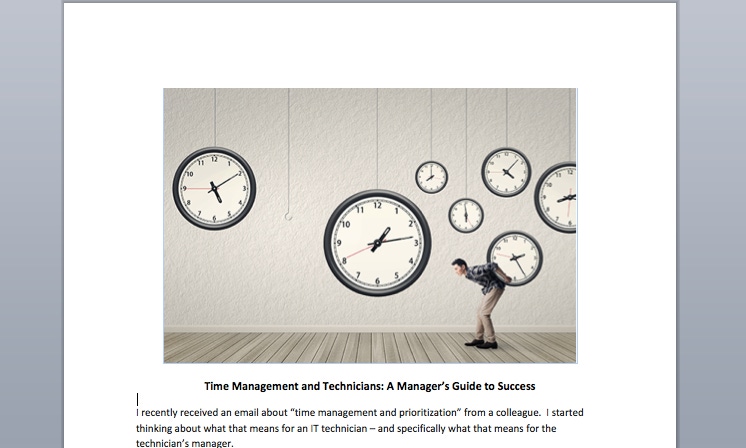I recently received an email about “time management and prioritization” from a colleague. I started thinking about what that means for an IT technician--and, specifically, what that means for the technician’s manager.
December 7, 2015

By Kaseya Guest Blog 1
 I recently received an email about “time management and prioritization” from a colleague. I started thinking about what that means for an IT technician–and, specifically, what that means for the technician’s manager.
I recently received an email about “time management and prioritization” from a colleague. I started thinking about what that means for an IT technician–and, specifically, what that means for the technician’s manager.
As Peter Drucker famously observed, “Time is the scarcest resource, and unless it is managed, nothing else can be managed.”
Whether you have one technician or a large team, it’s essential that you provide guidance and structure to make sure that they are handling support tickets appropriately, completely and professionally.
A technician is great at fixing problems and finding the root cause of a problem. You can just say, “I need you to go fix this or go take care of that,” or, “Let’s get this project done,” and they are on board. However, it doesn’t mean they are all skilled at true time management.
A technician occasionally getting overwhelmed can be managed through a quick reminder on how to prioritize tasks. However, if your technicians frequently run into trouble, here’s a handy three-step process to find the root cause.
Admit that you might be the problem.
You know, you may not be the best at time management either. Most MSP owners and managers started in a more technical role, where the reward is solving the problem that’s in front of you right now. So, you may not have thought as long as you should have on the best way to prioritize and route customer success tickets.
This is an especially easy trap for small MSPs, since it’s often faster to deal with the problem than create what may seem like a superfluous process. However, I try to remind people to start thinking about the ideal process as if you were a little bit larger. What would that look like in the next step of your evolution? Get that process in place before you reach that step.
Is it too easy for customers to reach your techs?
It’s natural to give customers a technician’s email address, especially when an MSP is starting out.
Many MSPs reading this blog probably remember doing exactly that. However, when your company is growing, and you keep responding to emails–and then phone calls on your cell–you realize sooner or later that you can’t keep up. The worst part is that you often can’t put a finger on exactly when managing all these calls started getting overwhelming.
In order to make technicians or engineers more effective, you need to clear out the noise for them. When customers call or email them directly, technicians are forced to decide what the biggest priority is. Because technicians are people, the prioritization can end up being based on an emotional response rather than a business or technical response. Which customer is making the most commotion? Which customer has a good relationship with the technician? This approach causes other customers to become frustrated–and to take that frustration out on the technician–if they are not responded to as soon as they should be. Being at the center of this storm can be too much pressure for many technicians, especially the less experienced ones.
Take back control.
Turn that pressure away from your technicians by setting up processes and policies that make you and “the company” in control of which ticket is handled next.
First, don’t provide direct email and phone numbers for your engineers. (And don’t provide cell numbers!) Instead, provide customers a way to report an issue (via phone, email and/or portal) directly to the “company” instead of to an individual technician. Then, establish company policies and systems to prioritize the next problem any single technician handles, based on factors such as financial impact, technical impact and the order of calls.
Free your engineers from the possibility of being the bad guys with the customer. Let them be appreciated for their work product. Even better, they won’t have to deal with the emotional stress of figuring out what they need to do next, even while trying to fix the problem currently on their plates.
Besides reducing technician burnout and churn, this centralized system gives you more insight into the most common customer support issues; allows for technicians to develop issue-specific expertise; and better ensures that you are deploying the right technician to work on the right problem at the right time.
Remember, it’s your business at the end of the day. Use these three steps to figure out how to improve technician productivity, and to increase the satisfaction of your engineers and, most importantly, your customers.
For more insights on improving MSP efficiency, download MSP Guide to Growth: Part III – Efficiency, Tools, and Best Practices.
J oining Kaseya in 2012, Miguel Lopez brings over 20 years of experience to his role as Senior Technical Director. In this position, he consults daily with Managed Service Providers (MSPs) to help them solve their clients’ business problems with technology solutions. Prior to joining Kaseya, Miguel served as the director of consulting services for All Covered, a nationwide technology services company that is a division of Konica Minolta Business Solutions USA Inc. In 2008, All Covered acquired NetCor Technologies, a leading MSP that Miguel founded and managed since 1997. NetCor specialized in serving highly regulated industries such as healthcare, CPAs, law firms and retail companies. Guest blogs such as this one are published monthly and are part of MSPmentor’s annual platinum sponsorship.
oining Kaseya in 2012, Miguel Lopez brings over 20 years of experience to his role as Senior Technical Director. In this position, he consults daily with Managed Service Providers (MSPs) to help them solve their clients’ business problems with technology solutions. Prior to joining Kaseya, Miguel served as the director of consulting services for All Covered, a nationwide technology services company that is a division of Konica Minolta Business Solutions USA Inc. In 2008, All Covered acquired NetCor Technologies, a leading MSP that Miguel founded and managed since 1997. NetCor specialized in serving highly regulated industries such as healthcare, CPAs, law firms and retail companies. Guest blogs such as this one are published monthly and are part of MSPmentor’s annual platinum sponsorship.
You May Also Like
